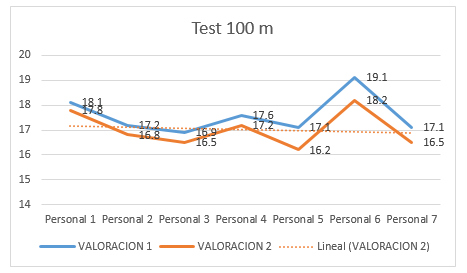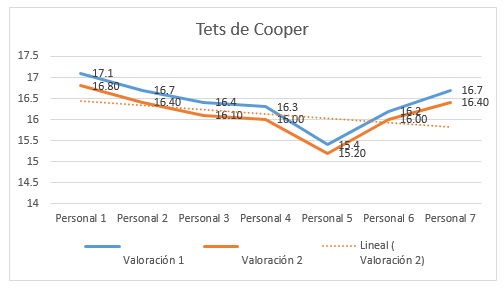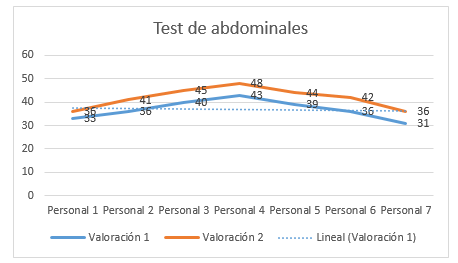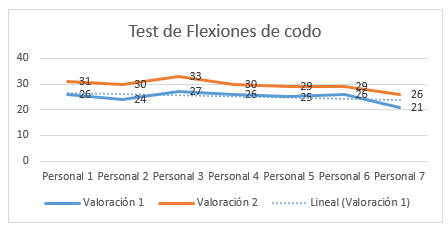Mi SciELO
Servicios Personalizados
Revista
Articulo
Indicadores
-
 Citado por SciELO
Citado por SciELO
Links relacionados
-
 Similares en
SciELO
Similares en
SciELO
Compartir
Podium. Revista de Ciencia y Tecnología en la Cultura Física
versión On-line ISSN 1996-2452
Rev Podium vol.17 no.2 Pinar del Río mayo.-ago. 2022 Epub 10-Ago-2022
Original article
Physical preparation for military women of the Naval Force in post-lactation period
1Universidad de las Fuerzas Armadas-ESPE. Quito, Ecuador.
Physical-military preparation includes numerous assumptions that regulate the operational readiness of military personnel, establish the basic standards for all active life. Within the work actions to improve or maintain physical condition, the conditions of the military must be taken into account, where the training of the post- lactation period of women must be conditioned to their biological needs. In this sense, the purpose of the research was to implement a training plan to improve the physical condition of military women of the naval force for the post -lactation period. Under an intentional sampling, seven women (31-36 years old) of the Ecuadorian naval force, in the process of breastfeeding, are inserted into a specialized exercise plan to condition them physically. From here, a study is generated in two moments of the preparation of their aerobic endurance, speed and local muscle power. All the assessment tests presented a lower mean performance in the first assessment. From this result, their indicators are exceeded as part of the post -test, Speed Test: 17:56-17:00 (p=0.018), Cooper Test: 16:38-16:12 (p=0.712), Abdominal Test:≈ 36rep-≈ 41rep (p=0.000) and elbow flexion test: 25rep-30rep (p=0.000). During the intervention process, there were no injuries or other difficulties that caused abandonment of the program. The proposed intervention plan improved and conditioned the physical training of military women of the Ecuadorian naval force in a post -lactation state; thus, it significantly improved speed capabilities and local muscle strength, which conditioned aerobic endurance capacity.
Keywords: Physical Preparation; Military Women; post-lactation; Exercise Plan; Naval Force.
INTRODUCTION
Physical activity during lactation is not only possible, but also beneficial for the mother (Martínez-Olcina, et al. 2020; Nguyen, et al., 2019). However, it requires guidelines that must be recommended by specialists. The Spanish Society of Gynecology and Obstetrics (Sego) suggests that when the birth has been normal, intense exercises should be started after six weeks after delivery and if the birth has been by caesarean section, they should be started eight weeks later. To do this, several recommendations must be kept in mind on how to avoid impact exercises in areas such as the abdominals and breasts.
According to Vázquez-Reina (2014), the practice of moderate exercise does not affect the composition or volume of breast milk. However, doing intense physical exercises can have a negative impact when the nursing mother does not have previous training. That is, a decrease in milk volume and an increase in lactic acid content can occur; this causes the rejection of breastfeeding by the baby. There are investigations that reject this hypothesis, when evaluating the reaction of children to breast milk after the practice of intense and moderate physical exercise. From this it is concluded that there are limitations regarding the differences in the amount of breast milk that the infant drinks and in his reaction to this precious liquid (Wright, Quinn, & Carey, 2002).
Lilian Bobea (2008) in her article: Women in uniform: the feminization of the Armed Forces. A study of the Dominican case, shows that, in Latin America, the incorporation of women into the Armed Forces is a response to the need to gain social legitimacy. This means that women are not on equal terms with men, especially in institutions that, like the military, are marked by a sexist, top-down, and authoritarian tradition (Bobea, 2008).
Gender equality has allowed women to be included in the career of the Ecuadorian military forces, Morales-Urrutia, (2021). This situation has marked a generational rupture, since the armed forces have been a space that has traditionally been occupied by men, who highlighted their role as strong warriors, contrary to the social fit for women, that is, as mothers and reproducers of chains of watch out.
Chacón (2020) indicates that the inclusion of women in the army, starting in the 1950s, has been determined by a series of improvised decisions. According to the Ministry of Defense, the first woman to graduate as a pilot from the Rotary Wing of the Naval Force was in 2011. While, in December 2013, there was an increase of 2.74 % in the number of women in all the Forces Ecuadorian Armed Forces, that is, 1090 women between officers and troop personnel (Chácon, 2020).
Military physical training is part of the physical preparation aimed at the development of aptitudes, skills and techniques of military life. Among others, the development of physical capacities such as strength, speed and endurance are considered (Larrea & Calero Morales, 2017; Kyröläinen, Pihlainen, Vaara, Ojanen, & Santtila, 2018; Brunyé, Martis, Kirejczyk, & Rock, 2019). This happens through specific physical stimuli that include races and basic gymnastics with or without weapons, various risk tests, passage through the ropes course, combat track, diving, combat swimming, self-defense, etc. (Army, 2020). Its execution is carried out during the day or at night according to its programming, which, of course, must be adapted to the needs of the officers in the post -lactation period.
Training methods are based on systematic procedures (Issurin, 2019; Calero., 2019). They must be developed to achieve the objectives set in a sports practice, for which the continuous method can be used; this is based on carrying out a prolonged effort for a long period of time with a medium or low intensity (Carrillo Aguagallo, et al., 2018). Pauses are not allowed and it is tried that there are no important changes of rhythm. Subdivisions of this method (intensive and extensive) should be considered.
Interval method cannot be used for the research context, since its application usually occurs in activities or sports such as track and field athletics, cycling and swimming. This aims to improve aerobic and anaerobic endurance in a much more intense way (Robalino-Cárdenas, Quelal-Paredes, Romero-Frometa, 2021).
In response to the above, this research aims to implement a training plan to improve the physical condition of military women of the Naval Force for the post-lactation period.
MATERIALS AND METHODS
The research had a critical and purposeful approach, since through the applied test the development of the continuous method was diagnosed to female military personnel of the Naval Forces in post-lactation. The study had a quantitative-qualitative cut, since statistical indices were analyzed through observation through value judgments regarding the feasibility of the Research. In addition, the data obtained were subjected to logical reasoning methods, which allowed to determine the respective conclusions regarding the context of the investigation.
The synthetic analytical method was used, which helped to process the treatment of theoretical information, obtained from primary and secondary sources, in which the 7th edition APA standards are applied, with the help of bibliographic managers such as Mendeley and Zotero. The research was field, this was developed with the female military personnel of the Naval Force of Ecuador who are in the post -lactation period. That is, the information has been obtained from reliable sources in a direct and real way.
The research is of an exploratory type, since it analyzes the particularities of the problem and directs it within the context of research, scientific inquiry, in order to contribute with a prospective solution in the immediate future. In addition, it is descriptive and explanatory, since the causes and consequences of the problem were determined with their respective analysis and interpretation of the results.
An intentional sample equivalent to the population composed of seven women between the ages of 31 and 36 from the Ecuadorian Naval Force, who are in the process of breastfeeding, was considered. They were participants in the development of the intervention plan during the period of eight weeks; they signed a consensus protocol. To obtain the data, the observation technique was applied with the help of an instrument such as the assessment test using a valid observation sheet, according to the context of the investigation. This allowed the collection of data on the performance achieved by the post -lactation personnel of the Naval Force. The data was subsequently processed and allowed to establish reliable facts that led to the appropriate conclusions.
The application of the exercise program was based on the continuous method for post-lactation women, taking into account the following considerations:
The mother was advised to breastfeed the baby, at least one hour after finishing the exercises, and with a moderate portion, since the milk may have a certain amount of lactic acid content.
Exercises that could cause trauma to the women's breasts were avoided.
It was reported that, as far as possible, the exercises will be performed after breastfeeding the baby, so that the breasts are not full and perform the exercises more comfortably.
The intensity of the exercises was developed in a moderate way and progressively increased in readjustment of load, intensity and density applied to the female military personnel of the Naval Force.
It was recommended to use a sports bra, so that the chest remains firm during the exercises. The material of the bra is cotton.
It was warned that each person must have control over their own limits, avoiding the feeling of extreme tiredness.
To avoid dehydration, it was indicated that you should drink plenty of fluids during and after the activity performed.
The exercise program or plan did not include swimming, in order to avoid puerperal endometritis, which can generate infectious processes that can affect postpartum women.
Weight lifting was avoided to avoid breast pain.
The training plan is an exercise program, which is based on the continuous method of exercises distributed over eight weeks, where military physical training was scheduled every Monday; rest was scheduled on Fridays; while training was directed at: aerobic endurance, endurance to fast strength and basic breathing technique. Physical and technical work in water was not considered since it is not recommended during the lactation stage, as explained previously. The programming included the following exercises carried out on Tuesday, Wednesday, Thursday and Saturday. Each day began with a 10-minute muscle activation, the respective set of exercises was performed and the respective stretching was performed for ten minutes, with their respective return to calm. The basic exercises performed were the following:
Continuous race 6 km intensity A5 in (30' to 45').
Initial 3 km jog functional exercises 3 x 4 30 min, intensity A5.
Ring work 4 x 400, 3 x 800, 2 x 1000, A5
Recovery 400 m low intensity.
Elbow push-ups 20 x 4.
Abdominal push-ups 20 x 4.
Ring work 4x 400, 3x 800, 2x 1000 recovery 400m, low intensity.
Elbow push-ups 20 x4.
Abdominal push-ups 20 x4.
Continuous race 7 km intensity A5 in (45' to 50').
Previous jog 3 km.
UDT intermittent work 15 x 3 rep.
Ring work 5 x 100, 4 x 200, 3 x 400, 2 x 800 active recovery 400 m.
Continuous race 7 km intensity A5 in (50´).
Continuous race 8 km intensity A5 in (55´).
Ring work 4 x 1000, 2 x 800, 3 x 200, 2 x 100 active recovery 400 m.
Previous jog 3 km, functional exercises 5x4 35 min intensity A4.
Physical evaluation of the training period according to physical test tables.
Jog 3 km, Functional exercises 6 x 4 30" intensity A4.
Continuous fartlek race 8 km intensity A4 in each km 40s of speed increase to 80 % (40´).
Ring work 2 x 800, 5 x 400, 5 x 200, 5 x 100 recovery 400m.
Jogging 3 km functional exercises 5 x 5 35min, intensity A5, with uniform.
Continuous fartlek race 8 km intensity A3 in each km 40s of speed increase to 80 % (40´).
Continuous fartlek race 6 km intensity A3 in each km 40s of speed increase to 80 % (35'), ring work.
Previous jog 2 km, functional exercises 6 x 4 30 min intensity A4.
Jogging 3 km, functional exercises 5 x 5 35 min, intensity A3.
Recovery jogging 3 km, optional recreational activities after physical evaluation.
Physical evaluation of the training period according to physical test tables.
For the physical evaluation, the 100m test, Cooper test (Point 0), Sit-ups (1.30) and Elbow Flexions (1.30) were applied. Therefore, the following elements were used: stopwatch, running track, basketball court or flat area that indicates the exact distances, sheets for recording the results. During the entire intervention process, there were no injuries or other difficulties that caused abandonment of the program, presenting an attendance of 100 % of the planned hours.
The data obtained from the two assessments planned in the exercise plan were tabulated and recorded in a Microsoft Excel 2019 spreadsheet. The arithmetic mean, mode and standard deviation were calculated. The valuations obtained were averaged and the results allowed the respective analysis and interpretation of the results in order to establish the pertinent conclusions. To determine the existence of significant differences when comparing the data obtained, the Shapiro-Wilk test was applied for small samples. The existence of normality was determined in the data obtained with the Cooper test, the abdominal test and the elbow flexion test, and the non-existence of a normal distribution of the data in the 100 m test. In the first cases, the Student `st test was applied for related samples (p≤0.05), and in the comparison of the 100m test, the Wilcoxon Signed Rank test (p≤0.05).
RESULTS AND DISCUSSION
Table 1 shows the results achieved in two moments of applying the 100 m speed test in the sample under study; the general values are visually described through figure 1 (Table 1).
Table 1. - Results with the 100m test (speed)
| Staff | ASSESSMENT 1 | VALUATION 2 |
| Staff 1 | 18:1 | 17:8 |
| Staff 2 | 17:2 | 16:8 |
| Staff 3 | 16:9 | 16:5 |
| Staff 4 | 17:6 | 17:2 |
| Staff 5 | 17:1 | 16:2 |
| Staff 6 | 19:1 | 18:2 |
| Staff 7 | 17:1 | 16:5 |
| MEAN ARIT. | 17:56 | five pm |
| Mode | 17:10 | 16:50 |
| STANDARD DEVIATION | 0.78 | 0.74 |
The results in the 100m test(Table 1) show an average initial speed or pretest of 17.56s; decreases to 17s as part of the posttest or second assessment, which is significantly different in favor of the posttest (p=0.018). These values are established according to the Wilcoxon Signed Range test, given the existence of 7 negative ranges. This was equivalent to the military 7 showing a noticeable improvement in speed capability; a yield increase of ±2.9 % is shown in percentage terms.
Figure 1 evidenced the tendency to reduce the time used by the soldiers studied from the individual point of view to complete the 100m test (Figure 1).
In the evaluation of endurance (Table 2), the Cooper test showed the results in the two moments of applying the intervention process briefly described in the Methods section; the aerobic capacity of the military studied is determined.
Table 2. - Results with the Cooper test
| Staff | Rating 1 | Rating 2 |
| Staff 1 | 17:1 | 16:80 |
| Staff 2 | 16:7 | 16:40 |
| Staff 3 | 16:4 | 16:10 |
| Staff 4 | 16:3 | 16:00 |
| Staff 5 | 15:4 | 15:20 |
| Staff 6 | 16:2 | 16:00 |
| Staff 7 | 16:7 | 16:40 |
| MEAN ARIT. | 16:38 | 16:12 |
| Mode | 16:70 | 16:40 |
| STANDARD DEVIATION | 0.54 | 0.50 |
As evidenced in Table 2, the mean time used to complete the Cooper test as part of assessment 1 was 16:38 min. A decrease in time is shown as part of Titration 2 at 16:12 min (Percent Increase: ±1.8%). No significant differences are revealed (p=0.712) as it was possible to establish with the Student's for related samples. However, since there is a lower average as part of the post- test, the authors of this research consider that the intervention proposal had a positive influence, although in a slight way. The lines presented in figure 2 are visually evidenced in the trend, it is recommended for future research to increase physical stimuli to better enhance the endurance capacity in the military in the post -lactation period (Figure 2).
On the other hand, table 3 shows the results achieved in local muscle power, through the abdominal test.
Table 3. - Abdominal test results
| Staff | Rating 1 | Rating 2 |
| Staff 1 | 33 | 36 |
| Staff 2 | 36 | 41 |
| Staff 3 | 40 | 45 |
| Staff 4 | 43 | 48 |
| Staff 5 | 39 | 44 |
| Staff 6 | 36 | 42 |
| Staff 7 | 31 | 36 |
| MEAN ARIT. | 36.46 | 41.29 |
| Mode | 36.00 | 36.00 |
| STANDARD DEVIATION | 4.14 | 4.50 |
The repetitions emitted by the population studied in the sit-up test(Table 3) were set as mean in the first assessment at ≈36rep; the mean was increased to ≈41rep as part of the second assessment (10.1 %). This situation causes a slightly linear trend to increase (Figure 3); it is shown to be significantly different in favor of the posttest (p=0.000), as statistically established with the Student's t- test. The foregoing shows that the intervention proposal was effective in improving local muscle power (Figure 3).
The results of the elbow flexion test are evidenced as part of table 4; local muscle power in the upper limbs is determined (Table 4).
Table 4. - Results of the elbow flexion test
| SURNAMES AND NAMES | Rating 1 | Rating 2 |
| Staff 1 | 26 | 31 |
| Staff 2 | 24 | 30 |
| Staff 3 | 27 | 33 |
| Staff 4 | 26 | 30 |
| Staff 5 | 25 | 29 |
| Staff 6 | 26 | 29 |
| Staff 7 | 21e | 26 |
| MEAN ARIT. | 24.85 | 29.58 |
| Mode | 26.00 | 30.00 |
| STANDARD DEVIATION | 2.00 | 2.14 |
The number of repetitions issued in the elbow flexion test was lower in the pretest (≈25rep) than the mean obtained as part of the posttest (≈30rep), as the number of repetitions increased individually (Figure 4). A significant difference prevails in favor of the second assessment (p=0.000) according to Student's t- test. A percentage increase in performance of ≈4 % was made, indicating that the intervention proposal improved local muscle power in the upper limbs.
The choice of an exercise plan according to the conditions of the military women of the Naval Force in the post -lactation period must consider factors such as avoiding causes that can generate trauma. It should be ensured that its impact is moderate, avoid dehydration and do not include exercises from the discipline of swimming. This is caused by the usual training where the interval method is implemented and the loads are mostly intensive (Robalino-Cardenas, Quelal-Paredes, & Romero-Frometa, 2021). In addition, the mother was instructed to practice breastfeeding before carrying out the exercise plan.
The physical-military preparation is an essential component for the professional of the armed forces, which includes the female gender, this begins with basic and specialized military training throughout the active life of military personnel, (Varley-Campbell, et al., 2018). In this sense, physical loads must be adapted to the needs of the trainee, including training aimed at reducing stress and anxiety specific to pregnancy. This can increase the risk of premature birth and low birth weight, for which physical loads need to be implemented even before the postlactation stage, as described in Weis, et al., (2020).
Based on the results of this research, it is recommended to expand the study sample to be researched. In addition, a personalized follow-up of each soldier studied must be carried out, with a view to prospectively perfecting the intervention process.
CONCLUSIONS
The proposed intervention plan contributed to the improvement and conditioning of physical preparation in military women of the Ecuadorian Naval Force in a postlactation state who were intervened. Speed capabilities and local muscle strength were significantly increased, aerobic endurance capacity was conditioned. During the intervention process, there were no health problems or injuries, it follows that the exercise plan implemented was sustainable.
REFERENCIAS BIBLIOGRÁFICAS
Bobea, L. (2008). Mujeres en uniforme: la feminización de las Fuerzas Armadas: Un estudio del caso dominicano. Nueva Sociedad, 213, 64-79. 19/06/2021. https://dialnet.unirioja.es/servlet/articulo?codigo=3989957 [ Links ]
Brunyé, T. T., Martis, S. B., Kirejczyk, J. A., & Rock, K. (2019). Camouflage pattern features interact with movement speed to determine human target detectability. Applied ergonomics, 77, 50-57. doi: 10.1016/j.apergo.2019.01.004 [ Links ]
Carrillo Aguagallo, A. M., Montoro Bombú, R., Lincango Iza, P. D., Mon López, D., Romero Frómeta, E., & Pérez Ruiz, M. E. (2018). Efectos del método continuo-extensivo para potenciar la resistencia aeróbica en trail running y fondo. Revista Cubana de Investigaciones Biomédicas, 37(3), 1-9. 11/06/2021. http://www.revibiomedica.sld.cu/index.php/ibi/article/view/133/141 [ Links ]
Chácon, R. (2020). Avances de Género en las Fuerzas Armadas Ecuatorianas: 20 años. Quito: Comando Conjunto de las Fuerzas Armadas del Ecuador. https://www.ccffaa.mil.ec/wp-content/uploads/sites/8/2021/03/Avances-del-genero-en-la-FFAA.pdf [ Links ]
Issurin, V. (2019). Entrenamiento deportivo.: Periodización en bloques. Barcelona: Paidotribo. https://paidotribo.com/products/entrenamiento-deportivo-periodizacion-en-bloques [ Links ]
Kyröläinen, H., Pihlainen, K., Vaara, J. P., Ojanen, T., & Santtila, M. (2018). Optimising training adaptations and performance in militaryenvironment. Journal of Science and Medicine in Sport, 21(11), 1131-1138. doi: 10.1016/j.jsams.2017.11.019 [ Links ]
Larrea, B., & Calero Morales, S. (2017). El rendimiento aeróbico del personal militar femenino en menos de 500 y más de 2 000 m snm. Revista Cubana de Investigaciones Biomédicas, 36(3), 1-10. 14/08/2021. http://scielo.sld.cu/scielo.php?script=sci_arttext&pid=S0864-03002017000300009 [ Links ]
Martínez-Olcina, M., Vicente-Martínez, M., Hernández-García, M., Loaiza-Martínez, D. A., Leyva-Vela, B., & Martínez-Rodríguez, A. (2020). Valoración de la influencia de un programa piloto de educación dietético-nutricional mediterránea y actividad física en madres lactantes. RevEspNutr Comunitaria, 26(1), 16-19. doi:10.14642/RENC.2020.26.1.5309 [ Links ]
Morales-Urrutia, X. (2021). Mujeres en las fuerzas armadas: el caso del ejército ecuatoriano. Revista de Ciencias de Seguridad y Defensa, 2(4), 125-131. doi:10.24133/rcsd.V2N4.2017.10 [ Links ]
Nguyen, P. T., Binns, C. W., Nguyen, C. L., Van Ha, A. V., Chu, K. T., Duong, D. V., & Lee, A. H. (2019). Physical activity during pregnancy isa sociated with improved breast feeding outcomes: a prospective cohort study. International journal of environment al research and publichealth, 16(10), 17-40. doi:10.3390/ijerph16101740 [ Links ]
Robalino-Cardenas, D. J., Quelal-Paredes, H. R., & Romero-Frometa, E. (2021). Análisis de la condición física de los cadetes que ingresan a la ESMIL durante el reclutamiento. Polo del Conocimiento, 6(2), 991-1004. doi:10.23857/pc.v6i2.2331 [ Links ]
Varley-Campbell, J., Cooper, C., Wilkerson, D., Wardle, S., Greeves, J., & Lorenc, T. (2018). Sex-specific changes in physical performance following military training: a system aticreview. Sports Medicine, 48(11), 2623-2640. doi:10.1007/s40279-018-0983-4 [ Links ]
Vázquez-Reina., M. (2014). ¿Cómo ejercitarse durante la lactancia? 15/06/2021. Fundación Eroski: Fundación Eroski: https://www.consumer.es/bebe/como-ejercitarse-durante-la -lactancia-tres-preguntas-con-respuesta.html [ Links ]
Weis, K. L., Walker, K. C., Chan, W., Yuan, T. T., &Lederman, R. P. (2020). Risk o fpretermbirth and new bornlow birthweight in military women with increased pregnancy-specificanxiety. Military medicine, 185(5-6), e678-e685. doi:10.1093/milmed/usz399 [ Links ]
Wright, K. S., Quinn, T. J., & Carey, G. B. (2002). Infant accept ance of breast milk after maternal exercise. Pediatrics (109), 585-589. doi:10.1542/peds.109.4.585 [ Links ]
Received: January 05, 2022; Accepted: February 28, 2022











 texto en
texto en 







